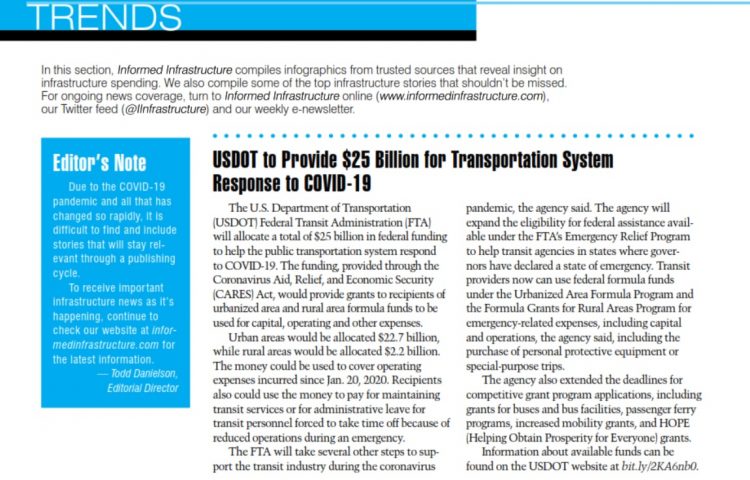May 2020 Trends

The U.S. Department of Transportation (USDOT) Federal Transit Administration (FTA) will allocate a total of $25 billion in federal funding to help the public transportation system respond to COVID-19. The funding, provided through the Coronavirus Aid, Relief, and Economic Security (CARES) Act, would provide grants to recipients of urbanized area and rural area formula funds to be used for capital, operating and other expenses.
Urban areas would be allocated $22.7 billion, while rural areas would be allocated $2.2 billion. The money could be used to cover operating expenses incurred since Jan. 20, 2020. Recipients also could use the money to pay for maintaining transit services or for administrative leave for transit personnel forced to take time off because of reduced operations during an emergency.
The FTA will take several other steps to support the transit industry during the coronavirus pandemic, the agency said. The agency will expand the eligibility for federal assistance available under the FTA’s Emergency Relief Program to help transit agencies in states where governors have declared a state of emergency. Transit providers now can use federal formula funds under the Urbanized Area Formula Program and the Formula Grants for Rural Areas Program for emergency-related expenses, including capital and operations, the agency said, including the purchase of personal protective equipment or special-purpose trips.
The agency also extended the deadlines for competitive grant program applications, including grants for buses and bus facilities, passenger ferry programs, increased mobility grants, and HOPE (Helping Obtain Prosperity for Everyone) grants.
Information about available funds can be found on the USDOT website at bit.ly/2KA6nb0.
According to the International Renewable Energy Agency (IRENA) and its first “Global Renewables Outlook,” the decarbonization of systems such as national and regional transport networks will support short-term recovery as well as create resilient and inclusive economies.
Although a pathway to deeper decarbonization requires total energy investment up to $130 trillion, the socio-economic gains of such an investment would be extensive, the Outlook suggests. Transforming the energy system could reportedly boost cumulative global GDP gains above business-as-usual by $98 trillion between now and 2050.
The full report can be accessed at bit.ly/2VIv8YM.
230,000 U.S. Bridges Need Repair, New Analysis of Federal Data Finds

Nearly 231,000 U.S. bridges need major repair work or should be replaced, according to an American Road & Transportation Builders Association (ARTBA) analysis of the U.S. Department of Transportation’s 2019 National Bridge Inventory (NBI) database. That figure represents 37 percent, or more than a third, of all U.S. bridges.
If placed end-to-end, the length of these bridges would stretch over 6,300 miles—long enough to make a round trip across the country from New York City to
Los Angeles and back again to Chicago. American drivers cross these bridges
1.5 billion times per day—representing one-third of all daily bridge crossings, according to the data. More than 46,000 of those bridges are “structurally
deficient” and in poor condition. They are crossed 178 million times a day.
National, state and local data are available in the report at
www.artbabridgereport.org.
TOP Stories
The following are the top stories from the last few months (in terms of traffic) on the Informed Infrastructure website. This also reflects key coverage areas that are regularly refreshed online and via our weekly e-newsletter. Simply search key words on Informed Infrastructure online to find the full story.
JCJ Architecture Selected for Architectural Design of New Fairfield Schools
Skanska Invests in a Climate-Neutral Office Project in Malmö, Sweden
AISI Publishes Two New Cold-Formed Steel Framing Test Standards
Johns Hopkins Proton Therapy Center Now Open
Transportation
BYD K11M 60-Foot Articulated Bus Passes Altoona Testing
DART’s New Interactive Digital Kiosks Bring Leading Edge Technology to North Texas Riders
Video: A Controversial FCC Vote
Water
Water Systems Council Introduces Infrastructure Planning Resource for Rural Communities
Highlighting the Importance and Vulnerability of the World’s Water Towers
DuPont Closes Four Clean Water Technology Acquisitions
Tools and Technology
Polyglass Enhances ADESO Self-Adhered Membranes
IQGeo Helps Peninsula Light Create Digital Twin of Electric Network
SJI’s Joist Girder Moment Connections Version 2.0 Now Available


